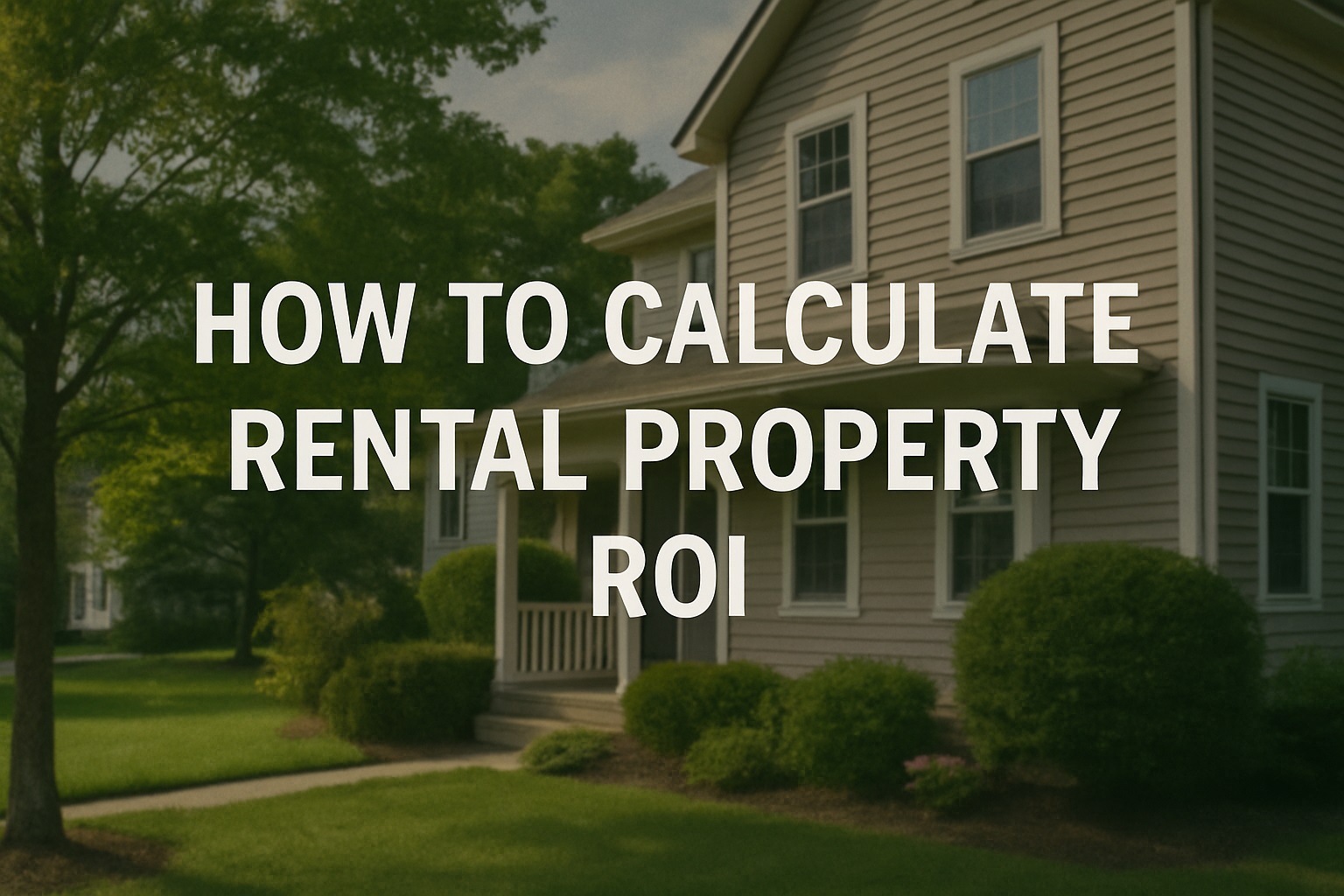Investing in rental properties can be a powerful wealth-building strategy, but success hinges on one critical metric: return on investment (ROI). Calculating ROI allows investors to compare opportunities, assess risk, and make data-driven decisions that maximize profitability. This extensive, 3,000-plus-word guide walks you through each step—explaining core concepts, formulas, case studies, and advanced tips—so you can evaluate rental properties confidently and accurately.
In this guide, you’ll learn:
- Why ROI matters and how it shapes investment choices
- Key ROI metrics: cap rate, cash-on-cash return, total ROI, and more
- Detailed, step-by-step ROI calculations with real-world examples
- How to gather precise financial data: income, expenses, financing
- Advanced modeling: internal rate of return (IRR) and discounted cash flow (DCF)
- Common mistakes to avoid and strategies for improving ROI
- Tax considerations that impact net returns
- Recommended tools, spreadsheets, and software for automation
- Frequently asked questions (FAQs)
By mastering these methods, you’ll uncover high-performing properties, negotiate better deals, and ensure your capital works as hard as possible.
Understanding Rental Property ROI
ROI measures the profitability of an investment relative to its cost. In rental real estate, ROI helps you answer questions such as:
- Which property yields the highest annual return based on purchase price?
- How does leveraging (using mortgage financing) affect your returns?
- What combination of purchase price, financing, rent, and expenses leads to the best cash-on-cash return?
ROI isn’t a single formula; it comprises multiple metrics, each highlighting a different performance aspect. The most common metrics include:
Cap Rate (Capitalization Rate)
The ratio of a property’s Net Operating Income (NOI) to its current market value or purchase price.
Cash-on-Cash Return
Annual pre-tax cash flow divided by the total cash invested, focusing on leveraged returns.
Total ROI
Incorporates cash flow, equity buildup through amortization, and property appreciation over a holding period.
Internal Rate of Return (IRR)
The discount rate that makes the net present value (NPV) of all cash flows equal zero, accounting for time value of money.
Gathering the Necessary Financial Data
Accurate ROI calculations rely on precise inputs. Before diving into formulas, assemble the following data:
Purchase Price
The agreed-upon price to buy the property. Include earnest money and expected closing costs for cash invested calculations.
Rental Income
- Gross Scheduled Income (GSI): Total potential rent if fully occupied.
- Effective Gross Income (EGI): GSI minus vacancy and credit loss allowances (typically 5–10%).
Operating Expenses
Annual costs to operate and maintain the property, including:
- Property taxes
- Insurance premiums
- Property management fees (if outsourced)
- Maintenance and repairs
- Utilities (if landlord-paid)
- HOA fees (if applicable)
- Landscaping, pest control, and other upkeep
Financing Details
If you plan to finance:
- Loan amount and down payment
- Interest rate and loan term (e.g., 30-year fixed at 4.5%)
- Points, origination fees, and other financing costs
Exit Assumptions
For multi-year ROI projections:
- Estimated annual property appreciation rate (e.g., 3% per year)
- Expected holding period (e.g., 5–10 years)
- Anticipated selling costs (real estate commissions, closing fees)
Step 1: Calculate Net Operating Income (NOI)
Net Operating Income represents the income a property generates after operating expenses but before debt service and taxes. It forms the basis for cap rate calculations.
Formula
NOI = Effective Gross Income (EGI) – Operating Expenses
Example
Imagine a small multifamily property with these annual figures:
- Gross Scheduled Income: €60,000 (4 units × €1,250/mo)
- Vacancy & Credit Loss: 5% of GSI = €3,000
- Effective Gross Income: €60,000 – €3,000 = €57,000
- Operating Expenses:
- Property taxes: €6,000
- Insurance: €1,500
- Management fees (8% of EGI): €4,560
- Maintenance: €2,500
- Utilities (landlord-paid): €1,800
- Miscellaneous: €1,140
- Total Expenses: €17,500
- NOI: €57,000 – €17,500 = €39,500
Step 2: Compute Capitalization Rate (Cap Rate)
Cap rate offers a quick snapshot of unleveraged returns, useful for comparing similar properties, including cash deals.
Formula
Cap Rate = NOI / Purchase Price × 100%
Example
Using the NOI from above (€39,500) and a purchase price of €550,000:
- Cap Rate = €39,500 / €550,000 × 100% ≈ 7.18%
A 7.18% cap rate indicates the property yields a 7.18% annual return based solely on operating income and purchase price, excluding financing effects.
Step 3: Calculate Cash Flow Before Taxes (CFBT)
Cash Flow Before Taxes (also referred to as Cash Flow) measures actual cash left after paying operating expenses and debt service.
Formula
CFBT = NOI – Annual Debt Service
Annual Debt Service
For financed deals, annual debt service equals the total of 12 mortgage payments.
Example
Assume a 75% Loan-to-Value (LTV) financing on a €550,000 purchase:
- Loan Amount: 75% × €550,000 = €412,500
- Down Payment: €137,500
- Mortgage Terms: 30-year fixed, 4.5% APR
- Monthly PI Payment: Use mortgage formula or amortization schedule; here it’s ≈ €2,092
- Annual Debt Service: €2,092 × 12 = €25,104
- CFBT: €39,500 – €25,104 = €14,396
A positive cash flow of €14,396 indicates the property generates surplus income after all expenses and debt.
Step 4: Determine Cash-on-Cash Return
Cash-on-Cash (CoC) Return evaluates leveraged returns by comparing annual cash flow to the actual cash invested.
Formula
CoC Return = CFBT / Total Cash Invested × 100%
Total Cash Invested
Includes down payment, closing costs, initial repairs, and any immediate reserves.
Example
Continuing the example:
- Down Payment: €137,500
- Closing Costs (estimated 3% of purchase price): €16,500
- Initial Repairs/Reserves: €5,000
- Total Cash Invested: €137,500 + €16,500 + €5,000 = €159,000
- CoC Return: €14,396 / €159,000 × 100% ≈ 9.05%
A 9.05% cash-on-cash return reflects the annualized yield on your actual cash outlay.
Step 5: Calculate Total ROI Over Holding Period
Total ROI accounts for cash flow, equity buildup through loan amortization, and property appreciation during your holding period.
Equity Buildup Component
Each mortgage payment includes principal reduction, increasing your equity in the property.
Formula
Total Principal Paid = Sum of principal portions of all payments over holding period
Example
Over the first five years of a 30-year loan, approximately €24,000 of principal is paid down (varies by amortization schedule).
Appreciation Component
Assume a conservative 3% annual appreciation on the €550,000 property.
Formula
Future Value = Purchase Price × (1 + Appreciation Rate)^{Years}
Example
FV after 5 years: €550,000 × (1 + 0.03)^5 ≈ €636,000
Appreciation Gain: €636,000 – €550,000 = €86,000
Total Profit and ROI
Total Profit
= Cumulative CFBT (5 years) + Principal Paid (5 years) + Appreciation Gain – Selling Costs
Assuming selling costs (commission, closing) at 7% of sales price (€636,000): €44,520
- Cumulative CFBT: €14,396 × 5 ≈ €71,980
- Principal Paid: €24,000
- Appreciation Gain: €86,000
- Selling Costs: €44,520
- Total Profit: €71,980 + €24,000 + €86,000 – €44,520 ≈ €137,460
Total ROI
= Total Profit / Total Cash Invested × 100%
= €137,460 / €159,000 × 100% ≈ 86.44%
An 86.44% total ROI over five years equates to an annualized internal rate of return (IRR) of roughly 13%.
Step 6: Advanced Modeling with IRR and DCF
For sophisticated investors, IRR and discounted cash flow (DCF) models incorporate the timing of cash flows and the cost of capital.
Internal Rate of Return (IRR)
The discount rate that sets the net present value (NPV) of all cash flows (in and out) to zero.
Discounted Cash Flow (DCF)
Calculates the present value of future cash flows using a chosen discount rate (e.g., desired hurdle rate).
Example IRR Calculation
Yearly cash flows: –€159,000 (initial), €14,396 (CFBT), …, €(CFBT + Sales Proceeds – Selling Costs) in final year. Compute IRR via spreadsheet or financial calculator, yielding ~13%.
Tools and Software for ROI Calculation
- Spreadsheets: Excel or Google Sheets with built-in financial functions (PMT, IRR, NPV).
- Online Calculators: BiggerPockets Rental Property Calculator, Roofstock ROI tool.
- Property Management Software: Stessa, Buildium, or AppFolio for automated income/expense tracking.
- Commercial Apps: Argus Enterprise for large-scale portfolios.
Common Pitfalls and How to Avoid Them
Underestimating Expenses
Failing to account for repairs, vacancies, or management fees can drastically skew ROI projections.
Overleveraging
High LTV ratios increase debt service and risk; target an LTV below 75% when possible.
Ignoring Opportunity Cost
Compare real estate returns to alternative investments (index funds, bonds) to ensure proper risk-adjusted returns.
Relying Solely on Cap Rate
Cap rates ignore leverage and appreciation; always calculate cash-on-cash return and total ROI.
Strategies to Improve ROI
- Raise Rents Strategically: Implement annual rent increases in line with market trends.
- Cost Control: Shop insurance and service contracts for better rates.
- Forced Appreciation: Renovate kitchens/bathrooms to justify higher rents and boost value.
- Tax Strategies: Use cost segregation studies to accelerate depreciation deductions.
Tax Considerations
- Depreciation: Residential rental properties depreciate over 27.5 years, creating non-cash deductions.
- 1031 Exchanges: Defer capital gains tax by rolling proceeds into a like-kind property.
- Passive Activity Rules: Passive losses may offset passive income but are subject to IRS limitations.
Consult a qualified tax advisor for personalized guidance.
Frequently Asked Questions (FAQs)
Q: What is a good cap rate?
A: In most markets, 5–10% cap rates indicate moderate to strong returns; high-risk areas may demand higher cap rates.
Q: How often should I recalculate ROI?
A: Reassess ROI annually or when major changes occur (rent increases, financing adjustments, market shifts).
Q: Should I include principal paydown in cash-on-cash return?
A: No. Cash-on-cash focuses on actual cash flow. Include principal paydown in total ROI or IRR calculations.
Q: How do vacancies affect ROI?
A: Vacancies directly reduce effective gross income; assume 5–10% vacancy for long-term modeling.
Q: Can I use ROI metrics for commercial properties?
A: Yes, but commercial deals may require additional metrics like Debt Yield and Loan-to-Value (LTV).
Final Thoughts
Accurate ROI calculations empower rental property investors to identify high-yield opportunities, manage risks, and scale portfolios strategically. By following the step-by-step processes—including NOI, cap rate, cash flow, cash-on-cash return, and total ROI—you’ll make informed decisions backed by data rather than guesswork. Coupled with advanced IRR modeling, robust software tools, and tax-smart strategies, your real estate investments can deliver consistent, market-beating returns.
Elevate your investment analysis and ensure your next rental purchase meets or exceeds your financial goals.








